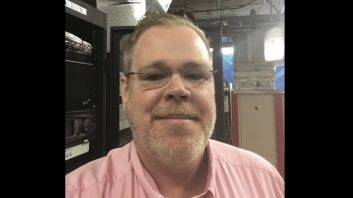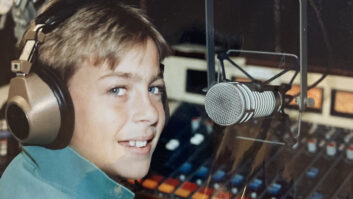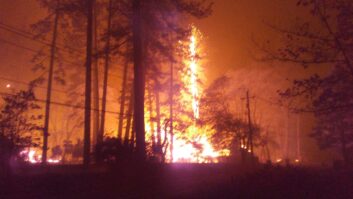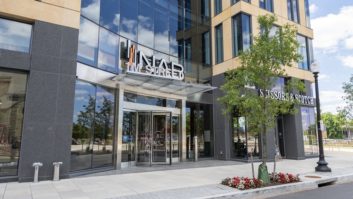Jim Leifer once chose a radio tech position over a job in TV because he thought radio was “sexier.” That career move is an example of Leifer’s passion for radio engineering and technology. In fact, the newly elected president of the Society of Broadcast Engineers spent nearly 30 years working in radio before joining American Tower Corp. in early 2017.
Leifer, 54, succeeds SBE President Jerry Massey and begins his term as president at SBE’s national meeting in Denver this month. Joining Leifer on the SBE board are Robert “RJ” Russell as vice president of the society, Wayne Pecena as secretary and Jim Bernier as treasurer.
SBE, which has 114 local chapters and about 5,200 members, offers a variety of professional certifications and educational opportunities for broadcast and multimedia technology professionals.
RADIO “HAS IT ALL”
Leifer, CPBE, is senior manager of broadcast operations at American Tower Corp. He worked for Paxson Communications/Ion Media and Clear Channel/iHeartMedia for nearly 30 years. Before leaving the latter last year, Leifer was VP of engineering for South Florida.
Leifer and his wife Jill have been married for 25 years and live in Boston. They have four children and several grandchildren.
“I’ve had quite a diversified career. I’ve designed and built and managed a lot of facilities in radio, TV and IT,” he said. “However, when I was given the opportunity to select between TV and radio, radio was undergoing the change from analog to digital platforms. At all of the SBE shows and chapter meetings, the vendors were showing off the new digital conversion opportunities and new ways of delivering audio using PC-based systems. This was a whole new way of delivery. This was the one chance to change the face of radio and get radio into the next generation of technology. I was excited about that and jumped in.”
Leifer thinks radio still presents challenging opportunities for new professionals coming into the field.
“The face of radio has changed. The new face has IP at the forefront. The day-to-day of never doing the same thing over and over again still is there in radio. For anyone that likes doing many different things and becoming an expert in them, it’s still the career for them. Radio has it all: computer networks, web-based streaming and video, RF transmission, live events, working through emergencies; and the list continues,” he said.
In his role as SBE president, Leifer said, he wants to grow membership and increase outreach through expanding the education it offers.
“Our web-based series of education programs has set record attendance. The webinars have had a tremendous response. We will continue to expand those offerings,” Leifer said.
Though recent membership numbers have trended down — thanks to fewer available engineering jobs combined with retirements — the society leadership feels that overall its numbers have held up well.
“We want to be more inclusive. We want to reach out to those professionals who might not be called a broadcast engineer these days but are doing some of the same jobs,” Leifer said.
“The broadcast industry is changing. The position of broadcast engineer and media professional is modifying. Instead of transmitters our members now might be managing audio streams now, but essentially they are still doing many of the same things. We want to make sure we include those people in our mix. The IT world in the engineering space is becoming a more prominent thing, and we must make sure we can accommodate those professionals.”
Leifer said the group’s national meeting presents an opportunity to focus on its membership and its needs for education and certification.
“The IT skill set is becoming increasingly important for our members,” he said, noting that SBE offers Certified Broadcast Network Technologist and Certified Broadcast Network Engineer certifications, which he said have had good response. “And the overall modern IP-centric broadcast infrastructure has become more of a focus of ours.”
The quick turnover of technology in the broadcast plant brings challenges in terms of implementation and reliability.
“The next big thing is something to allow the broadcast engineer to interface all of these systems and pieces in a more simplified manner. If you have digital consoles, digital STL and a remote control, there isn’t one place to go to do everything. It needs to be streamlined,” he said.
“IT developers have to stand and deliver now. Perfect the craft and make it reliable. The next big thing I expect is something that will allow the broadcast engineer to integrate all of these tech pieces in a simplified manner. Right now we still have kind of a hodgepodge of technologies. If someone can figure it out, then broadcasters could centralize even more of their operations.”
RECRUITING
SBE acknowledges the challenge it and the broadcast industry continue to face in attracting young tech talent. Leifer said the group’s mentoring program has helped.
“We have stepped up recruiting high and college students to the field. We are doing our best to support broadcasters who start programs to excite young professionals about the opportunities broadcast tech provides,” Leifer said. “We are losing some numbers to retirement but we are making progress. There are young people entering the profession through the IT lane. Some broadcast groups, like Beasley and iHeartMedia, are bringing in young people to train them as the next generation of engineers.”
Meanwhile, the workloads on existing broadcast engineers continue to increase, which makes education even more important, Leifer said.
“The job of the broadcast engineer is now more complicated than it was 15 years ago. It’s because of the complexity of the technology. Members crave it so they can do their jobs better. If the workload is increasing, then the need for education and training is growing,” he said.
Leifer said he expects TV’s spectrum repack to be the subject of many conversations among radio techs in coming months.
“Having backup facilities in ready condition will be vital. If a tower crew is coming on-site, communication with them will be critical. Most of these projects will not be one-day operations. They’ll take weeks to complete. The key task of every engineer will be to minimize the impact on their broadcast facility.”
SBE has applauded FCC Chairman Ajit Pai’s AM revitalization efforts and supports ideas that will help bring relief to broadcasters and broadcast engineers, Leifer said.
“I’m excited to one day sit down with Chairman Pai and discuss with him ways we, as broadcast engineers, can help him and in turn help us. There are lots of different flavors to revitalization. FM translators for AM broadcasters is part of it; but that really doesn’t fix the problem. It’s a Band-Aid. The real fix is to abate the AM noise. Chairman Pai is totally aware of our willingness to help,” Leifer said.
He noted that SBE worked with the FCC’s Technological Advisory Council on a noise study for a short time in 2016, but then TAC tabled the study. “We certainly still support a noise floor study and would jump at the opportunity to help.”
The FCC is doing a better job now of enforcement against pirate radio broadcasters, Leifer said, but is still shorthanded to complete the job.
“The FCC does not have the Enforcement Bureau staff numbers to do proper enforcement. We wrote ex-parte comments to the FCC regarding staff reductions. We believe Congress is moving in the proper direction to get the pirates shut down.”







